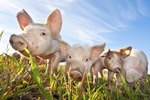With domestic animals, it's best for nature to take her course during and after birth, with humans intervening only when necessary. In the case of a mother pig and her piglets, you may need to intervene. In nature, a lot of those piglets die. That's because it's not uncommon for mother pigs to accidentally crush newborn piglets while in the process of delivering her litter. As many as a quarter of newborn piglets die before reaching the age of 6 weeks. That doesn't mean their mothers didn't care for them -- it's simply the fact that the newborns are tiny and the mothers are huge. The crushing doesn't occur only with large commercial breeds. Even potbellied pigs, bred as pets, will crush some of their offspring if the babies aren't removed while the mother is still in labor.
Warnings
Mother pigs become very protective of their newborns. They don't know you are trying to help save their offspring, and may attack.
Saving the Piglets
For best results, keep a close eye on the expectant mother. The average pig pregnancy lasts 114 days. A few days before giving birth, her teats will swell up, possibly hitting the ground as she waddles. You'll notice her vulva enlarging. Prepare a clean pen for the pig to farrow, or give birth. Once the sow starts delivering, remove each piglet and place it in a box warmed by a heat lamp. Keep the temperature at between 80 and 90 degrees. Once the sow finishes delivering her litter and passes the afterbirth, you must place the piglets with her for their vital first meal.
Colostrum and Feeding
The piglets must have that colostrum, that essential first milk full of antibodies, within an hour of birth. Each piglet suckles from one particular teat. The strongest piglets suckle from the front teats, which produce more milk. The weakest piglets suckle in the back, and may not receive sufficient nourishment. If a litter is especially large, expect piglet deaths unless you transfer some of the weaker piglets to a foster sow or hand-feed them. Piglets will nurse until the age of about 6 weeks, and you can introduce some food into their diets starting at about the age of 2 weeks.
Writer Bio
Jane Meggitt has been a writer for more than 20 years. In addition to reporting for a major newspaper chain, she has been published in "Horse News," "Suburban Classic," "Hoof Beats," "Equine Journal" and other publications. She has a Bachelor of Arts in English from New York University and an Associate of Arts from the American Academy of Dramatics Arts, New York City.





